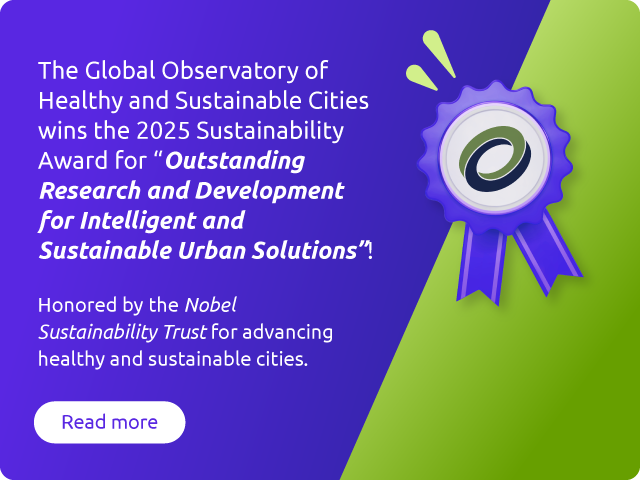The Lancet Global Health 2022 Series on Urban Design, Transport and Health
About the Series
Good city planning produces co-benefits for individual and planetary health and wellbeing. In 2016, a Series on Urban Design, Transport and Health was published in The Lancet, drawing attention to the importance of integrated upstream city planning policies as a pathway to creating healthy and sustainable cities. City planning policies determine the local built environment and transport features that influence transportation choices and affect exposures to health risk and protective factors. The 2016 Lancet Series proposed a set of city planning indicators that could be used to benchmark and monitor cities.
The Lancet Global Health Series on Urban Design, Transport, and Health, published in May 2022, follows up on the 2016 Series in The Lancet. In this new Series, we demonstrate how those indicators can be used to measure urban design and transport policies and features in cities.
We present the results of a 3.5 year case study in 25 cities in 19 lower-middle and high-income countries where we conducted policy analysis and assessed built environment and transport features using geospatial indicators. We also identified thresholds for built environment interventions that could help achieve the World Health Organization’s target for increasing physical activity by 15% by 2030. Through this new Series in The Lancet Global Health, we show how the indicators can guide decisions about what must change in order to create healthy and sustainable cities; how research can be used to guide urban policy to achieve urban and population health; create tools so that cities can replicate our indicators, and explore ‘what next’ is needed to create healthy and sustainable cities, particularly in light of the COVID-19 pandemic and climate change.
Series articles
Click here to download an infographic summarizing the key findings of the 2022 series of urban planning, transport and health in The Lancet Global Health.
Series launch events
The Lancet Global Health Series on Urban Design, Transport and Health launches on May 10, 2022. Two webinars will take place as part of the launch activities, and are open to the public. If you are interested in attending, please register here (May 10) or here (May 12).
In addition to the official Series launch by The Lancet Global Health, a series of local events to disseminate the methods and findings presented in this new Series will take place across the globe, as follows:
Other publications
Soleimani Roudi, A., Higgs, C., Gunn, L., Butt, A., Adlakha, D., Resendiz, E., … Lowe, M. (2025). Determinants and indicators of healthy, climate resilient cities: a scoping review. Cities & Health, 1–22. https://doi.org/10.1080/23748834.2025.2558288
Turner, R., C. Higgs, V. Heikinheimo, et al. 2025. “Internationally Validated Open Access Indicators of Large Public Urban Green Space for Healthy and Sustainable Cities.” Geographical Analysis 1–16. https://doi.org/10.1111/gean.70023.
Mabry, R., Al Siyabi, A., Al Siyabi, H., Al Anquodi, Z., De Siqueira, G., & Lowe, M. (2025). Urban Design and Transport Planning for Physical Activity, Health, and Well-Being: Do Cities in Oman Meet Evidence-Informed Policy Standards?. Journal of Physical Activity and Health (published online ahead of print 2025). Retrieved Sep 15, 2025, from https://doi.org/10.1123/jpah.2025-0184.
Favarão Leão, A. L., Franco Silva, M., Gierbolini-Rivera, R. D., Shaw, C., O’Connor, Á., Resendiz Bontrud, E., … Reis, R. S. (2025). Spatial and policy analysis of livability in the city of St. Louis, Missouri, USA. Cities & Health, 1–11. https://doi.org/10.1080/23748834.2025.2526258.
Lowe M. Healthy, climate resilient urban environments: Evidence to action. In: Renard N, editor. The Veolia Institute Review FACTS Reports no. 27, Health and the environment: understanding, anticipating and acting in the face of climate change. Paris, France: Veolia Institute, 2025. https://www.institut.veolia.org/
Higgs, C., Lowe, M., Giles-Corti, B., Boeing, G., Delclòs-Alió, X., Puig-Ribera, A., Adlakha, D., Liu, S., Borello Vargas, J. C., Castillo-Riquelme, M., Jafari, A., Molina-García, J., Heikinheimo, V., Queralt, A., Cerin, E., Resendiz, E., Singh, D., Rodriguez, S., Suel, E., … Alderton, A. (2024). Global Healthy and Sustainable City Indicators: Collaborative development of an open science toolkit for calculating and reporting on urban indicators internationally. Environment and Planning B: Urban Analytics and City Science, 0(0). https://doi.org/10.1177/23998083241292102
Adlakha, D., Resendiz, E., Vernez Moudon, A., Sallis, J., Higgs, C., Giles Corti, B., Salvo, D., Cerin, E., Boeing, G., Liu, S., and Lowe, M. (2024). The Global Observatory of Healthy and Sustainable Cities: Indicators to Inform Urban Planning Worldwide. (El Observatorio Global de Ciudades Saludables y Sostenibles: Indicadores para informar la planificación urbana a nivel mundial). NotasCPAU(A publication of Consejo Profesional de Arquitectura y Urbanismo/Professional Council of Architecture and Urbanism). Open access (Spanish and English): https://revistanotas.org/revistas/55/2738-el-observatorio-global-de-ciudades-saludables-y-sostenibles
Featured in: World Bank. 2023. Chapter 2: How Inclusive Are Cities Today? in Enablers of Inclusive Cities: Enhancing Access to Services and Opportunities. Washington, DC: World Bank. http://hdl.handle.net/10986/40642
山田拓実, 竹内萌恵, 成澤拓実, 福島渓太, 塩崎洸, 高橋哲也, … & 樋野公宏. (2023). 日本の基礎自治体における身体活動を促進する都市計画政策の現状 1000 Cities Challenge の指標を用いた試行的評価. 都市計画報告集, 21(4), 486-491.
https://doi.org/10.11361/reportscpij.21.4_486
Lowe, M., Sallis, J. F., Salvo, D., et al. (2022). A pathway to prioritizing and delivering healthy and sustainable cities. Journal of City Climate Policy and Economy, 1(1), 111-123. https://doi.org/10.3138/jccpe-2022.1.1.0008
Liu, S., Higgs, C., Arundel, J., Boeing, G., et al. (2022). A generalized framework for measuring pedestrian accessibility around the world using open data. Geographical Analysis, 54(3), 559-582. https://doi.org/10.1111/gean.12290
City
Adelaide
Date
20-Sep-2022
Time
To be confirmed
Local contact
*More local events to be confirmed


















